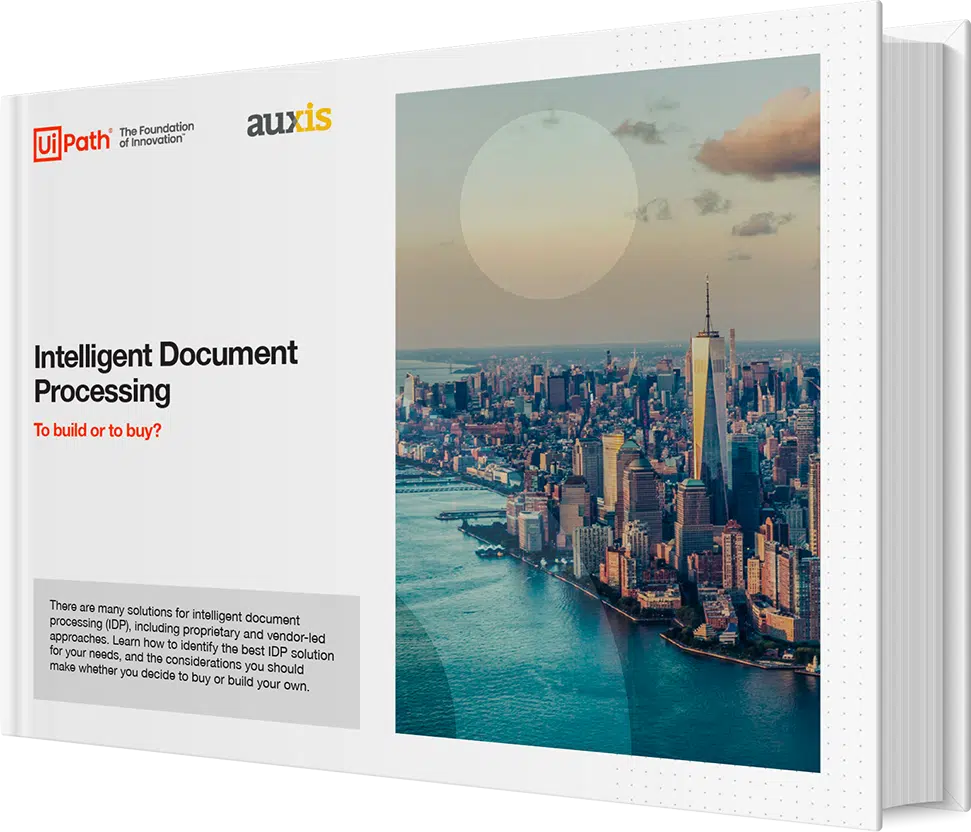As organizations accelerate their digital transformation, one obstacle continues to slow progress: the overwhelming volume of documents that drive daily operations. Invoices, contracts, employee applications, and purchase orders hold essential business data, but much of it remains buried in unstructured or semi-structured formats that resist automation.
Manual document handling not only consumes valuable time but also drains resources, introduces errors, and limits scalability. Intelligent Document Processing (IDP) is changing that. By combining AI, machine learning, and OCR, IDP goes beyond basic scanning to extract, classify, and validate data with remarkable speed and accuracy.
The momentum behind IDP is undeniable. Valued for its ability to improve data accuracy and accelerate workflows, the global IDP market is expected to reach $11.6 billion by 2029, growing at a 29.7% CAGR. For organizations striving to modernize their back-office operations, IDP has become a cornerstone of digital efficiency.
In this article, we will explore the most powerful IDP use cases transforming productivity across finance, HR, and other business-critical functions.
Top intelligent document processing use cases
The applications for Intelligent Document Processing are enterprise-wide, but its transformative impact is most pronounced within the core operational functions that run on a high volume of documents. Departments like finance, human resources, and IT see immediate benefits from automating their document-centric workflows. The following use cases demonstrate how organizations are creating new levels of efficiency and insight in each of these critical areas.
Finance & accounting
Modern finance leaders face mounting pressure to deliver more than accurate reports. They are expected to provide real-time insights, optimize cash flow, and maintain strict compliance standards, all while managing leaner teams and tighter deadlines. Yet manual, document-heavy processes continue to slow progress, creating data delays, increasing the risk of errors, and diverting valuable time away from strategic analysis.
Intelligent Document Processing (IDP) directly tackles these challenges. By automating the extraction, document classification, and validation of data from invoices, purchase orders, and other key financial documents, IDP enables faster and more accurate decision-making. The result is a finance function built on efficiency, transparency, and data integrity, allowing teams to focus less on paperwork and more on driving business performance.
Accounts payable
For many organizations, Accounts Payable is a tactical, high-volume cost center burdened by manual invoice processing. This approach not only increases operational costs but also leads to missed early-payment discounts, strained vendor relationships, and a lack of real-time visibility into enterprise spend.
IDP fundamentally transforms Accounts Payable into a strategic, value-driving function. By automating invoice capture, PO matching, and approval routing, it provides greater control and visibility across the entire payables process. This level of efficiency enables finance leaders to optimize payment timing, capture early-payment discounts, and use spend data to improve negotiations and budgeting.
Accounts receivable
Cash flow is core for every organization, and a slow Order-to-Cash (O2C) cycle can quickly strain working capital and liquidity. Manual processes within Accounts Receivable, from entering sales orders to applying cash, often create bottlenecks that increase Days Sales Outstanding (DSO) and limit growth.
Intelligent Document Processing accelerates cash flow by streamlining these critical steps. It automates the capture of customer purchase orders, processes remittance advice in real time, and matches payments to open invoices with high accuracy. By reducing manual intervention and clearing receivables faster, IDP helps organizations lower DSO, strengthen liquidity, and maintain healthier cash positions.
These results are not theoretical. According to Deloitte, organizations that implement document automation achieve a 35% increase in efficiency and a 25% reduction in processing costs, demonstrating how IDP delivers measurable financial impact.
Record to report
The Record-to-Report (R2R) process, particularly the final stages of financial close, is a high-pressure period where accuracy and timing are critical. Finance teams often spend countless hours gathering supporting documents and performing reconciliations, leaving limited capacity for meaningful analysis and decision-making.
By integrating Intelligent Document Processing (IDP) into the close cycle, organizations gain the speed, precision, and consistency needed to complete reporting faster and with greater confidence. Automated data extraction from bank statements, sub-ledger reports, and supporting documentation enhances data integrity, strengthens the audit trail, and shortens the close timeline. The result is more time for finance teams to focus on strategic insights that drive better business performance
Human resources
Human Resources plays a critical role in shaping workforce performance and company culture, but the function is still burdened by manual, document-intensive processes that slow productivity and increase compliance risks. Managing resumes, contracts, performance reviews, and onboarding forms requires significant administrative effort that pulls teams away from higher-value priorities.
Modern HR organizations are turning to Intelligent Document Processing to eliminate these inefficiencies. By digitizing and automating workflows across the entire employee lifecycle, from recruitment and onboarding to performance management and offboarding, teams can process information faster, ensure greater accuracy, and maintain stronger compliance. This transformation allows HR to shift its focus from administrative work to people, strategy, and culture, positioning the function as a true driver of business value.
Employee onboarding
The employee experience begins on day one. A slow, paper-heavy onboarding process creates a poor first impression and delays a new hire’s time-to-productivity. Intelligent Document Processing digitizes and automates the collection of all onboarding paperwork—from I-9s and W-4s to benefits enrollment forms—by extracting the relevant data, validating it for completeness, and seamlessly updating your HRIS. This ensures a smooth, compliant, and welcoming experience for every new employee.
Talent acquisition
In a competitive market, talent is won with speed and precision. Sifting through hundreds of resumes manually is a bottleneck that can cause top candidates to accept offers elsewhere. Intelligent Document Processing automates the resume screening process, instantly extracting key data like skills, experience, and qualifications to create a searchable talent pool, allowing recruiters to identify the best-fit candidates in minutes, not days.
Payroll
Payroll is one of the most critical functions in any organization, and its accuracy is a non-negotiable. Intelligent Document Processing reinforces payroll integrity by automating the ingestion of variable data from timesheets, commission statements, and bonus calculation forms. By eliminating manual data entry, IDP significantly reduces the risk of errors that can lead to incorrect payments and employee dissatisfaction.
Benefits administration
Managing benefits, especially during the chaos of open enrollment or qualifying life events, is a complex, document-intensive challenge. Intelligent Document Processing streamlines the process by automatically extracting employee selections from various enrollment and change-of-status forms. This ensures that relevant data is captured accurately and transmitted correctly to benefits providers, mitigating compliance risks and administrative headaches.
Managing the employee lifecycle and offboarding
From promotions and transfers to terminations, every change in employee status generates a paper trail that must be managed carefully. IDP processes these diverse documents, ensuring that records are always up-to-date. For offboarding, it ensures all final documentation, from final pay calculations to COBRA notifications, is handled efficiently and compliantly, protecting the organization from potential legal and financial risks.
Information technology
Modern IT departments are the backbone of the enterprise, focused on maintaining systems and providing critical technical support. However, they still face operational drag from manual, document-based workflows, especially in how they receive and process internal support requests from unstructured channels like email.
A primary application for IDP within IT is to revolutionize IT Service Management (ITSM). The technology acts as an intelligent intake layer, automatically ingesting support requests from emails and PDF attachments. It then extracts key data like user details, classifies the issue type based on content, and determines the urgency.
This structured data is then used to automatically create a perfectly formed ticket in systems like ServiceNow or Jira, ensuring it is routed to the correct support queue instantly. This automation eliminates manual triage, leading to significantly faster response times, more effective resource allocation, and a highly efficient service desk.
Your partner in IDP transformation
Harnessing the full potential of IDP requires more than just purchasing Intelligent Document Processing software. True transformation comes from a strategic approach that combines cutting-edge technology with a deep understanding of the underlying business processes you aim to improve. Without a clear roadmap, even the most powerful tools can fail to deliver their expected return on investment.
The key to success lies in partnering with an expert who can analyze your unique operational workflows, identify the highest-value use cases, and seamlessly integrate intelligent document processing solutions into your existing technology ecosystem. This ensures that automation efforts are aligned with your broader business objectives, from reducing operational costs to enhancing data accuracy and scalability.
For organizations ready to unlock the next level of back-office efficiency, Auxis provides the expertise to turn that vision into reality. As a platinum UiPath partner with decades of experience in finance, HR, and IT transformation, we don’t just implement technology; we re-engineer your processes for a digital-first world. Our unique nearshore model empowers your business with the elite talent and strategic guidance needed to make your intelligent automation journey a resounding success.
If you are curious to see how Intelligent Document Processing can streamline your operations, connect with our experts or explore our learning center for more insights.
Frequently Asked Questions
What is the most common use case for IDP?
Can IDP handle handwritten documents?
What is the difference between OCR and IDP?
How do you measure the ROI of an IDP solution?


